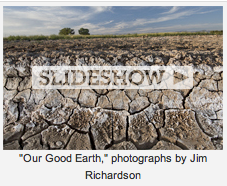Mann starts out describing in great detail just how stunningly bad things are: 7.5 million acres degraded worldwide from compaction, erosion and deforestation (according to the most comprehensive report of its kind, which is now 17 years old…). From America’s breadbasket in the Midwest where $400,000 satellite-guided tractors literally take the breath out the soil by squeezing out all the air, to wrong-headed one-size-fits-all Maoist farm policies turned the Loess Plateu, one of the most fertile places on the planet, into “arguably the worst soil erosion in the world,” it is a devastating picture of agricultural folly.
Just when you think there can’t possibly be any good news, Mann switches gears, describing a handful of “lost” techniques for soil restoration: Cordons pierreux – lines of strategically placed fist-size stones for erosion control. Zai holes – shallow pits seeded with manure to attract termites whose digestion of the manure releases nutrients, triggering a virtuous circle of soil health. And terra preta, a mysterious carbon-and-pottery-shard rich man-made soil that made the great pre-Columbian cultures of South America possible (also see Mann’s fascinating book, “1491: New Revelations of the Americas Before Columbus”).
These were all simple, brilliant and, at one time, widely adopted practices, a.k.a. successful technologies. Beyond the compelling puzzle of how and why good ideas get forgotten, there is hope in their rediscovery.
I was particularly intrigued by terra preta, a soil which can retain its fertility for centuries, and attempts to create a terra preta nova.
(italics added):
…Terra preta is found only where people lived, which means that it is an artificial, human-made soil, dating from before the arrival of Europeans. Neves and his colleagues have been trying to find out how the Amazon’s peoples made it, and why. The soil is rich in vital minerals such as phosphorus, calcium, zinc, and manganese, which are scarce in most tropical soils. But its most striking ingredient is charcoal—vast quantities of it, the source of terra preta’s color. Neves isn’t sure whether Indians had stirred the charcoal into the soil deliberately, if they had done it accidentally while disposing of household trash, or even if the terra preta created by charcoal initially had been used for farming. Ultimately, though, it became a resource that could sustain entire settlements; indeed, Neves said, a thousand years ago two Indian groups may have gone to war over control of this terra preta…
…Sombroek had wondered if modern farmers might create their own terra preta--terra preta nova, as he dubbed it. Much as the green revolution dramatically improved the developing world’s crops, terra preta could unleash what the scientific journal Nature has called a “black revolution” across the broad arc of impoverished soil from Southeast Asia to Africa.
Key to terra preta is charcoal, made by burning plants and refuse at low temperatures. In March a research team led by Christoph Steiner, then of the University of Bayreuth, reported that simply adding crumbled charcoal and condensed smoke to typically bad tropical soils caused an “exponential increase” in the microbial population—kick-starting the underground ecosystem that is critical to fertility. Tropical soils quickly lose microbial richness when converted to agriculture. Charcoal seems to provide habitat for microbes—making a kind of artificial soil within the soil—partly because nutrients bind to the charcoal rather than being washed away. Tests by a U.S.-Brazilian team in 2006 found that terra preta had a far greater number and variety of microorganisms than typical tropical soils—it was literally more alive…
“…A black revolution might even help combat global warming. Agriculture accounts for more than one-eighth of humankind’s production of greenhouse gases. Heavily plowed soil releases carbon dioxide as it exposes once buried organic matter. Sombroek argued that creating terra preta around the world would use so much carbon-rich charcoal that it could more than offset the release of soil carbon into the atmosphere. According to William I. Woods, a geographer and soil scientist at the University of Kansas, charcoal-rich terra preta has 10 or 20 times more carbon than typical tropical soils, and the carbon can be buried much deeper down. Rough calculations show that “the amount of carbon we can put into the soil is staggering,” Woods says. Last year Cornell University soil scientist Johannes Lehmann estimated in Naturethat simply converting residues from commercial forestry, fallow farm fields, and annual crops to charcoal could compensate for about a third of U.S. fossil-fuel emissions. Indeed, Lehmann and two colleagues have argued thathumankind’s use of fossil fuels worldwide could be wholly offset by storing carbon in terra preta nova….”
Although the motivation was to create a cheap and comparatively clean cooking fuel in area that were either deforested or heading in that direction, there may be yet another benefit: terra preta.
Amy Smith meet Johannes Lehmann. Johannes Lehmann meet Amy Smith. Now (to quote SNL’s Mike Myers as “Coffee Talk’s” Linda Richman), discuss amongst yourselves! (and please keep me posted…)










